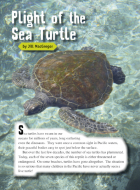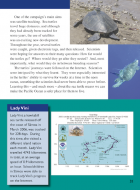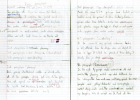You are here:
By the end of year 6

Reading
Reading
The transition into year 5 brings with it a significant step up in terms of the demand for students to use their reading as an interactive tool for learning. Although they continue to read texts as part of their literacy learning programme, most of the texts that students are now required to read are instructional materials from across the curriculum. The texts and tasks are similar for students in year 5 and year 6. Students read in order to locate, evaluate, and integrate information and ideas within and across a small range of texts as they generate and answer questions to meet specific learning purposes across the curriculum.
During these two years, students continue to develop their accuracy and fluency as readers of a variety of texts. They increase their level of control and independence in selecting strategies for using texts to support their learning. By the end of year 6, students are required to read longer texts more quickly and to select appropriate strategies for different reading purposes more effectively than students in year 5.
When students at this level read, respond to, and think critically about texts, they:
- monitor their reading for accuracy and sense, demonstrating that they have the confidence to adjust their reading (e.g., by varying the speed of reading, by rereading, and by attending to the most important information) when they encounter difficulties;
- understand how they select from and use their repertoire of comprehension strategies, which include:
- making connections between their prior knowledge and the concrete examples in a text in order to understand abstract ideas in the text
- locating and summarising ideas (e.g., by skimming or scanning, by identifying key words, topic sentences, and key questions, or by using subheadings)
- drawing on several related items of information in order to infer ideas and information that are not directly stated in the text
- evaluating and integrating ideas and information across a small range of texts;
- regularly read for sustained periods and sustain meaning over many days in longer texts (such as novels) and across a variety of texts on the same topic;
- identify and reflect on writers’ purposes and on the ways in which writers use language and ideas to suit their purposes (e.g., by using vocabulary to set a scene or develop a mood).
They draw on knowledge and skills that include:
Rich vocabulary instruction encourages students to develop word consciousness by thinking actively about word meanings, word structures, and how they might use and understand those words in different situations.
page 73
- decoding texts fluently and accurately, using a range of reliable strategies;
- finding and learning the meanings of unknown vocabulary by using strategies such as applying their knowledge of how words work or seeking explanations in the text or in illustrations;
- understanding that words and phrases can have figurative as well as literal meanings and that some words have different meanings depending on the context;
- recognising basic grammatical constructions and understanding how these affect meaning;
- identifying the specific language features and structures of many common continuous and non-continuous text types (including mixed text types);
- interpreting illustrations, photographs, text boxes, diagrams, maps, charts, and graphs.
Reading Standards Illustrations: Illustrations of text relating to specific curriculum tasks and its reading demands can be viewed here. These illustrations are examples that show how a student is meeting the reading standards through a curriculum task.
Writing
Writing
The transition into year 5 brings with it a significant step up in terms of the demand for students to use their writing as an interactive tool for learning. Although they continue to create texts as part of their instructional writing programme, most of the texts that students are required to write in years 5 and 6 are intended to meet the demands of the curriculum. The texts and tasks are similar for students in year 5 and year 6. They use their writing to think about, record, and communicate experiences, ideas, and information to meet specific learning purposes across the curriculum.
During these two years, students write about increasingly challenging subject matter. They increase their level of control and independence in selecting processes and strategies to write texts for a range of purposes that includes recounting, describing, narrating, reporting, arguing, and explaining. By the end of year 6, students are required to write more complex texts than students in year 5. They independently create texts that are appropriate for their purposes and audiences, choosing effective content, language, and text structures.
When students at this level create texts, they:
- understand their purposes for writing and identify writing processes that are appropriate for those purposes;
- use a variety of planning activities, such as constructing flow charts, for those writing tasks that need to be planned;
- generate content that is usually relevant to the task, supporting or elaborating their main ideas with detail that has been selected with some care;
- independently revise and edit their writing to clarify its meaning and add impact, often in response to feedback;
- proofread to check the spelling, grammar, and punctuation, using appropriate computer- based or print tools.
They draw on knowledge and skills that include:
- using an overall text structure that is appropriate for their purpose, e.g., an orientation, a problem, a climax, and a satisfying resolution (for a narrative) and an introduction, a series of main points, and a logical conclusion (for a report);
- selecting vocabulary that is appropriate to the topic, register, and purpose (e.g., academic and subject-specific vocabulary appropriate for specific learning areas or precise and descriptive words to create a mental image);
- using written language features (such as emotive vocabulary) and visual language features (such as headings, charts, or maps) to extend or clarify meaning and to engage their audience;
- using their knowledge of how words work (e.g., knowledge of diverse phoneme–grapheme relationships, of common, reliable spelling rules and conventions, and of the meanings and spellings of morphemes), along with their knowledge of word derivations, to fluently and correctly encode most unfamiliar words, including words of many syllables;
- correctly spelling all high-frequency words1 used in their writing;
- organising related ideas into paragraphs (e.g., paragraphs comprising a topic sentence with supporting detail) and beginning to use cohesive devices to link paragraphs;
- using simple and compound sentences that are correct grammatically and have a variety of structures, beginnings, and lengths and using some complex sentences that are mostly correct grammatically;
- using basic punctuation that is mostly correct (e.g., when punctuating dialogue);
- attempting some complex punctuation (e.g., using apostrophes for possession, commas for clauses, or semicolons).
Writing Standards Illustrations: Illustrations of students' texts provide a snapshot of the skills and strategies the students have used to meet the writing demands of the curriculum can be viewed here. These illustrations are examples that show how the student is meeting the writing standards through a curriculum task.
1. High-frequency words at this level could, for example, include all those in the lists of essential words in Croft (1998).




